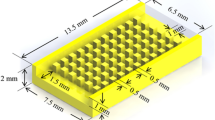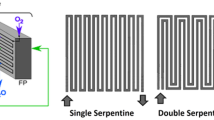Abstract
In this manuscript, a numerical investigation on the temperature gradient of a magnetic refrigerator using different geometric configurations of a parallel plate regenerator is presented. The parallel plate regenerator is made up of gadolinium (Gd) as a magnetocaloric material with rectangular channels. The parallel plate regenerator is modeled and numerically investigated for 3D conjugated fluid convection and conduction heat transfer using Ansys Fluent. Two piston-cylinder displacers drive water as the working fluid through the regenerator loop. The hot and cold end heat exchangers are treated with the ε-NTU method. The effect of changing the parallel plate regenerator’s dimensional parameters on temperature span is examined against the utilization factor of 0.1, keeping the regenerator’s porosity constant. The maximum temperature span is predicted by comparing simulated parallel plate magnetic regenerators for two diverse sets of dimensional parameters and surface areas is 36.5 K for magnetic field intensity of 0.8 T.
Similar content being viewed by others
References
J. Rodríguez-Muñoz and J. Belman-Flores, Review of diffusion- absorption refrigeration technologies, Renew. Sust. Energ. Rev., 30 (2014) 145–153.
M. I. H. Khan, Conventional refrigeration systems using phase change material: a review, Int. J. Air-Conditioning and Refrig., 24 (2016) 1630007.
J. Abdulateef, K. Sopian, M. Alghoul and M. Sulaiman, Review on solar-driven ejector refrigeration technologies, Renew. Sust. Energ. Rev., 13 (2009) 1338–1349.
J. A. Barclay, Magnetic refrigeration: a review of a developing technology, Advances in Cryogenic Engineering (R. W. Fast Edition), Springer, 33 (1988) 719–731.
B. Yu, Q. Gao, B. Zhang, X. Meng and Z. Chen, Review on research of room temperature magnetic refrigeration, Int. J. Refrig., 26 (2003) 622–636.
R. Bjørk, C. R. H. Bahl, A. Smith and N. Pryds, Review and comparison of magnet designs for magnetic refrigeration, Int. J. Refrig., 33 (2010) 437–448.
C. Zimm, A. Jastrab, A. Sternberg, V. Pecharsky, K. Gschneidner, M. Osborne and I. Anderson, Description and performance of a near-room temperature magnetic refrigerator, Advances in Cryogenic Engineering (P. Kittel Edition), Springer, 43 (1998) 1759–1766.
B. Monfared, R. Furberg and B. Palm, Magnetic vs. vaporcompression household refrigerators: a preliminary comparative life cycle assessment, Int. J. Refrig., 42 (2014) 69–76.
J. R. Gómez, R. F. Garcia, A. D. M. Catoira and M. R. Gómez, Magnetocaloric effect: a review of the thermodynamic cycles in magnetic refrigeration, Renew. Sust. Energ. Rev., 17 (2013) 74–82.
C. Aprea, A. Greco, A. Maiorino and C. Masselli, A comparison between different materials with mechanocaloric effect, Int. J. Heat Technol., 36 (2018) 801–807.
M. H. Phan and S. C. Yu, Review of the magnetocaloric effect in manganite materials, J. Magn. Magn. Mater., 308 (2007) 325–340.
V. K. Pecharsky and K. A. Gschneidner Jr., Magnetocaloric effect and magnetic refrigeration, J. Magn. Magn. Mater., 200 (1999) 44–56.
K. K. Nielsen, C. R. H. Bahl, A. Smith, R. Bjørk, N. Pryds and J. Hattel, Detailed numerical modeling of a linear parallel-plate active magnetic regenerator, Int. J. Refrig., 32 (2009) 1478–1486.
V. Pecharsky and K. Gschneidner Jr., Effect of alloying on the giant magnetocaloric effect of Gd5(Si2Ge2), J. Magn. Magn. Mater., 167 (1997) L179–L184.
K. Gschneidner Jr. and V. Pecharsky, Thirty years of near room temperature magnetic cooling: where we are today and future prospects, Int. J. Refrig., 31 (2008) 945–961.
A. Smaıli and R. Chahine, Thermodynamic investigations of optimum active magnetic regenerators, Cryogenics, 38 (1998) 247–252.
P. V. Trevizoli, J. R. Barbosa Jr. and R. T. Ferreira, Experimental evaluation of a Gd-based linear reciprocating active magnetic regenerator test apparatus, Int. J. Refrig., 34 (2011) 1518–1526.
B. Siddikov, B. Wade and D. Schultz, Numerical simulation of the active magnetic regenerator, Comput. Math. with Appl., 49 (2005) 1525–1538.
J. Dikeos, A. Rowe and A. Tura, Numerical analysis of an active magnetic regenerator (AMR) refrigeration cycle, AIP Conference Proceedings, American Institute of Physics (2006) 993–1000.
K. Engelbrecht, G. Nelli and S. Klein, A numerical model of an active magnetic regenerator refrigeration system, Cryocoolers, Springer, 13 (2005) 471–480.
T. F. Petersen, N. Pryds, A. Smith, J. Hattel, H. Schmidt and H. J. H. Knudsen, Two-dimensional mathematical model of a reciprocating room-temperature active magnetic regenerator, Int. J. Refrig., 31 (2008) 432–443.
P. A. Oliveira, P. V. Trevizoli, J. R. Barbosa Jr. and A. T. Prata, A 2D hybrid model of the fluid flow and heat transfer in a reciprocating active magnetic regenerator, Int. J. Refrig., 35 (2012) 98–114.
A. Rowe and A. Tura, Experimental investigation of a threematerial layered active magnetic regenerator, Int. J. Refrig., 29 (2006) 1286–1293.
C. Aprea, A. Greco and A. Maiorino, Magnetic refrigeration: a promising new technology for energy saving, Int. J. Ambient Energ., 37 (2016) 294–313.
C. Aprea, A. Greco, A. Maiorino and C. Masselli, Magnetic refrigeration: an eco-friendly technology for the refrigeration at room temperature, Journal of Physics: Conference Series, IOP Publishing (2015) 012026.
M. S. Kamran, J. Sun, Y. B. Tang, Y. G. Chen, J. H. Wu and H. S. Wang, Numerical investigation of room temperature magnetic refrigerator using microchannel regenerators, Appl. Therm. Eng., 102 (2016) 1126–1140.
W. M. Kays and M. E. Crawford, Convective Heat and Mass Transfer, McGraw Hill, Inc., New York (1993).
Y. Cengel, Heat Transfer: A Practical Approach, 2nd Edition (2003) 420–422.
Acknowledgments
This work is supported by the University of Engineering and Technology, Lahore, Pakistan, and the Higher Education Commission of Pakistan.
Author information
Authors and Affiliations
Corresponding author
Additional information
Samia Sadaf is serving as a Lecturer in the Mechanical Engineering Department, Lahore Leads University, Pakistan. She received her B.Sc. degree from the University of Engineering & Technology Lahore, Pakistan. She has completed her Master’s degree in Mechanical Design Engineering from UET Lahore, Pakistan. Her research interests are computational fluid dynamics, magnetic refrigeration, and material sciences.
Muhammad Ammar is an Assistant Professor of the Department of Chemical Engineering Technology, Government College University, Faisalabad, Pakistan. He received his Ph.D. in Chemical Engineering from the University of the Chinese Academy of Sciences, Beijing, China. His research interests include metallic materials for heat transfer, energy storage, and heterogeneous catalysis.
Rights and permissions
About this article
Cite this article
Sadaf, S., Kamran, M.S., Qasim, M. et al. Numerical investigation of temperature span of magnetic refrigerator using geometric configuration of gadolinium based parallel plate regenerator. J Mech Sci Technol 35, 2219–2227 (2021). https://doi.org/10.1007/s12206-021-0438-y
Received:
Revised:
Accepted:
Published:
Issue Date:
DOI: https://doi.org/10.1007/s12206-021-0438-y




